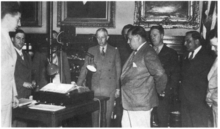Historical Records Survey
The Historical Records Survey (HRS) was a project of the Works Progress Administration New Deal program in the United States. Originally part of the Federal Writers' Project, it was devoted to surveying and indexing historically significant records in state, county and local archives. The official mission statement was the "discovery, preservation, and listing of basic materials for research in the history of the United States."

Organization
Organized on November 15, 1935 under the direction of Luther H. Evans with a budget of $1,195,800, the Survey began life under the Federal Writers' Project. It became an independent division of Federal Project Number One in October 1936 within the Works Progress Administration's Women's and Professional Division. In 1939, with more artistic federal programs under attack from Congress, partly because they employed suspected Communists, the less controversial HRS was moved to the Work Projects Administration Research and Records Program, Professional and Service Division.[1] The program was shut down February 1, 1943.
In 1939 the federal government handed off the program's activities to willing state governments; each state had its own supervisor co-ordinating the Survey's activities.[1]
The HRC, headquartered in Washington, D.C., was organized into subdivisions (regional, state, district) and much of the work was done at the behest of the National Archives and Records Administration or state archive agencies. The HRS sometimes cooperated with the Daughters of the American Revolution and other volunteer groups with an interest in local history and genealogy.
The HRS was generally considered the most efficient and inexpensive of the Federal One projects. However, because of the program's short lifespan, many of the indexes were not published and remain in only piecemeal form in local and state record repositories.
Achievements
According to Clifton Dale Foster,[1]
In most states, several diverse projects were operating simultaneously. Its largest project was the Survey of County Records, which located, identified, arranged, and described massive amounts of public records found in county archives. The result was the publication of some 628 volumes of inventories. Other programs of major importance included the Survey of Federal Archives, directed by Philip M. Hamer; the Survey of Church Records; and the American Imprints Inventory.
Other accomplishments included the soundex indexes for several of the states for several of the late 19th-century U.S. Censuses (1880, 1900, 1910, 1920), indexes of vital statistics, book indexes, bibliographies, cemetery indexes and newspaper indexes, the Atlas of Congressional Roll Calls Project, a historical index of American musicians, surveys of portraits in public buildings, maritime records, a history of grazing, a food history project called America Eats, and a necessary survey of the federal Archives—NARA itself had been established only in 1934.
The Survey also innovated in archival practice. For example, it made use of new microfilm technology, experimented with its use in archiving, and advanced on previously existing practices.[1]
See also
- Rena Vale, Los Angeles writer
References
- Foster, C.D. (1985). "Microfilming Activities of the Historical Records Survey, 1935-42". American Archivist. 48: 45–55.
Further reading
- Child, Sargent B. and Holmes, Dorothy P., Check List of Historical Records Survey Publications, Baltimore: Genealogical Publishing Co., 1969. A reprint of the public domain WPA Technical Series, Research and Records Bibliography No. 7, "Bibliography of Research Projects Reports - Check List of Historical Records Survey Publications", Revised April, 1943, created by the Federal Works Agency, Work Projects Administration.
- Hefner, Loretta, The WPA Historical Records Survey: a guide to the unpublished inventories, indexes, and transcripts, Society of American Archivists. ISBN 0-931828-25-2
- Kelly, Andrew, Kentucky by Design: The Decorative Arts and American Culture (Lexington, Kentucky: University Press of Kentucky, 2015). ISBN 978-0-8131-5567-8
- McDonald, William F. Federal Relief Administration and the Arts (Columbus, Ohio: Ohio State University Press, 1969), pp. 751–827.
- Smiley, David L., "The W.P.A. Historical Records Survey," in In Support of Clio: Essays in Memory of Herbert A. Kellar, ed. by William B. Hesseltine and Donald R. McNeil (Madison, Wis.: State Historical Society of Wisconsin, 1958).